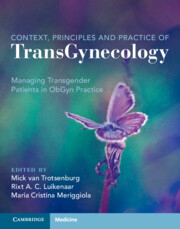Book contents
- Context, Principles, and Practice of Transgynecology
- Context, Principles, and Practice of Transgynecology
- Copyright page
- Dedication
- Contents
- Foreword
- Preface
- Contributors
- Abbreviations
- Section A Contextual Transgynecology
- Section B Practicing Transgynecology
- Section C Gynecological Surgery for Transgender Males
- Section D Sexuality and Contraception
- Section E Fertility and Reproduction
- Chapter 24 Fertility Counseling for Transgender and Nonbinary People
- Chapter 25 Management of Fertility for the Trans Masculine Individual
- Chapter 26 Fertility Maintenance for Trans Women
- Chapter 27 Fertility Prospects Related to Puberty Blocking Therapy
- Chapter 28 Medico-legal Entanglements of Assisted Reproduction
- Chapter 29 Obstetrical Care for Trans Persons
- Chapter 30 Uterine Transplantation for Trans Women: Prerequisites and Limitations
- Section F Impact of Gender-affirming Hormonal Therapy on Genital Organs
- Section G Screening and Prophylaxis
- Transgynecology Index
- References
Chapter 29 - Obstetrical Care for Trans Persons
from Section E - Fertility and Reproduction
Published online by Cambridge University Press: 22 December 2022
- Context, Principles, and Practice of Transgynecology
- Context, Principles, and Practice of Transgynecology
- Copyright page
- Dedication
- Contents
- Foreword
- Preface
- Contributors
- Abbreviations
- Section A Contextual Transgynecology
- Section B Practicing Transgynecology
- Section C Gynecological Surgery for Transgender Males
- Section D Sexuality and Contraception
- Section E Fertility and Reproduction
- Chapter 24 Fertility Counseling for Transgender and Nonbinary People
- Chapter 25 Management of Fertility for the Trans Masculine Individual
- Chapter 26 Fertility Maintenance for Trans Women
- Chapter 27 Fertility Prospects Related to Puberty Blocking Therapy
- Chapter 28 Medico-legal Entanglements of Assisted Reproduction
- Chapter 29 Obstetrical Care for Trans Persons
- Chapter 30 Uterine Transplantation for Trans Women: Prerequisites and Limitations
- Section F Impact of Gender-affirming Hormonal Therapy on Genital Organs
- Section G Screening and Prophylaxis
- Transgynecology Index
- References
Summary
Many men of transgender experience have female reproductive organs and are capable of getting pregnant and carrying out a pregnancy. While the prevalence of pregnancy among transgender men is uncertain, it is likely that the number of pregnancies in this population is increasing and will continue to rise with greater social acceptance, visibility, and healthcare support.
- Type
- Chapter
- Information
- Context, Principles and Practice of TransGynecologyManaging Transgender Patients in ObGyn Practice, pp. 218 - 227Publisher: Cambridge University PressPrint publication year: 2022



